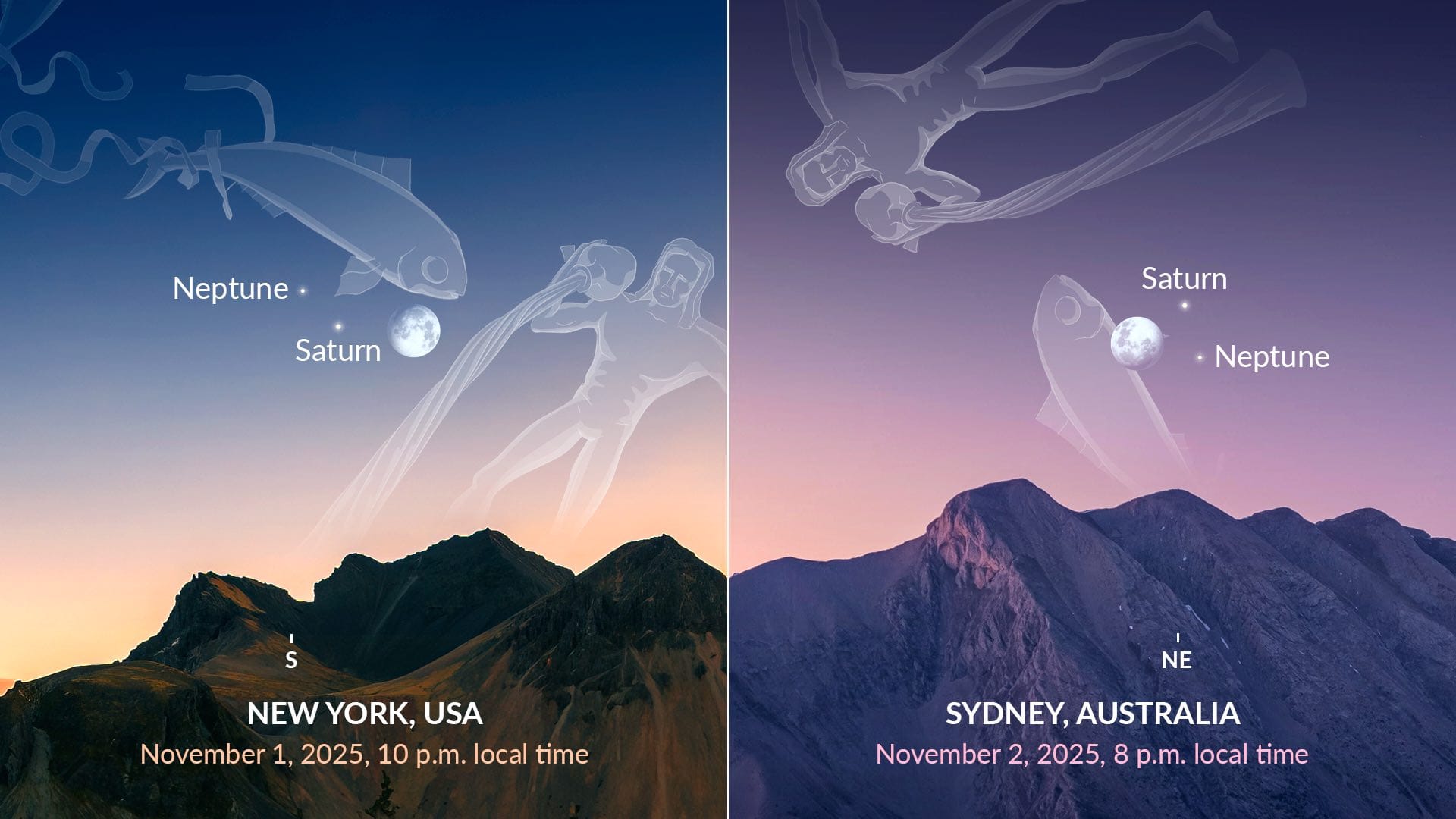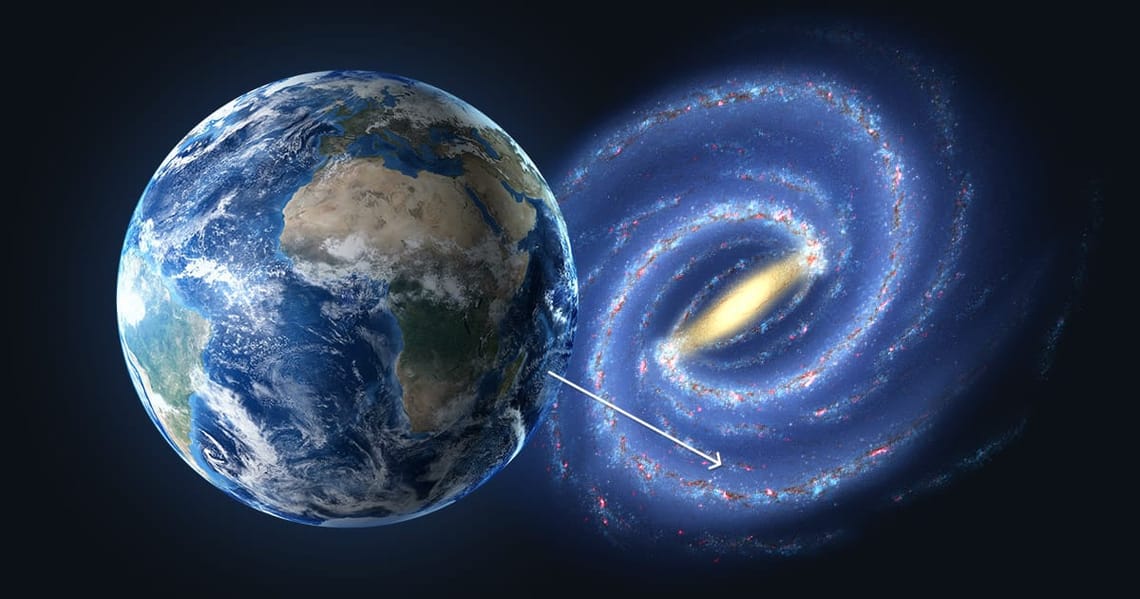Moon, Saturn, and Neptune Form a Triangle on November 1 and 2
On the evening of November 1 or 2, 2025 (depending on your location), look up to see the Moon and two planets get close together in the sky. The almost full Moon (about 90% illuminated) will shine brightly beside Saturn and the much fainter Neptune, creating a celestial trio that links three worlds across billions of kilometers. Use the Sky Tonight app to trace this elegant arrangement in the constellations Aquarius and Pisces.
Contents
- Moon Meets Saturn and Neptune: What to expect
- When and where to see the Moon, Saturn, and Neptune
- How to see and photograph the Moon–Saturn–Neptune triangle
- Other celestial objects to see on November 1 and 2, 2025
- Why you shouldn’t miss this Moon–planets meetup
- Moon meets Saturn and Neptune: Summary
Moon Meets Saturn and Neptune: What to expect
The Moon, Saturn, and Neptune will form a triangular pattern in the evening sky. The best dates to see the triangle will be November 1 for observers in the Northern Hemisphere and November 2 for those in the Southern Hemisphere. On November 2, viewers in the Northern Hemisphere will see the three bodies lined up almost in a straight line, rather than forming a triangle.
- The Moon, dazzling at mag -12.0, dominates the view.
- Saturn (mag 0.8) sits a few degrees west of the Moon, easily visible to the naked eye.
- Neptune (mag 7.7) also lies just a degree or two away, but is much fainter and requires optical aid.
The trio will remain above the horizon for several hours after sunset, decorating the southern sky in the Northern Hemisphere and northern sky in the Southern Hemisphere. Want to learn about other upcoming encounters between the Moon and planets? Read our article.
When and where to see the Moon, Saturn, and Neptune

The best time to watch the trio is between 18:00 and 22:00 local time, right after evening twilight, when the Moon is climbing higher in the evening sky. The triangle will be best viewed on November 1 from the Northern Hemisphere and on November 2 from the Southern Hemisphere. Look toward the south-southwestern horizon in the Northern Hemisphere, or to the north-northeast if you’re in the Southern Hemisphere. During the event, the Moon and Neptune will drift through Pisces, while Saturn will glow nearby in Aquarius, close to the border between the two constellations. In the Northern Hemisphere, the group will appear moderately high above the horizon, and in the Southern Hemisphere, even higher.
How to see and photograph the Moon–Saturn–Neptune triangle
-
By eye. Give your eyes a few minutes to adjust to the darkness before looking up. As your vision adapts, you’ll easily notice the bright Moon and golden Saturn shining close together, even from city skies. Neptune is far too faint to see without optical aid, so it’s completely invisible to the naked eye.
-
With binoculars. Standard 7–10× binoculars will enhance the view. Move slowly around the Moon to notice Saturn’s steady golden light; both objects are impressive in binoculars. Under very dark conditions, you might just detect Neptune as a tiny bluish point, though this is uncommon. Hold your binoculars steady or rest them on a tripod for the clearest image.
-
Through a telescope. At 50–100× magnification, you might see a few of Saturn’s moons. Neptune will show up as a small, soft blue disk instead of a point of light. Adjust the magnification gradually to get the sharpest possible image for the current atmospheric conditions.
-
With a camera. Mount your camera on a tripod and focus at infinity. Try short exposures (around 1/500 to 1/125 second) and keep ISO between 100 and 400 to prevent the Moon from overexposing. Saturn may appear as a small golden point beside the Moon, while Neptune is too dim for a single frame. Capture several images and choose the sharpest ones for the best result.
-
With a smartphone. Place your phone on a tripod or stable surface to avoid any movement. Activate the manual or pro mode if available, and set ISO to around 100–400 with an exposure time between 1/250 and 1/60 second. Some newer phones include a dedicated astrophotography or night-sky mode; use it to enhance faint details. The Moon will appear bright, Saturn may show up as a small point, and Neptune will remain invisible.
If you’d like to capture celestial scenes like this one, check out our guide “Astrophotography for Beginners” — it explains how to photograph the night sky using both cameras and smartphones.
Other celestial objects to see on November 1 and 2, 2025
Later in the evening in the Northern Hemisphere and during the night in the Southern Hemisphere, Jupiter will rise in the east and will become a bright counterpoint to the Moon–Saturn–Neptune trio. Meanwhile, the Summer Triangle asterism will be glimmering low in the west. You can find all of these objects (including the asterism) using the free Sky Tonight app.
Why you shouldn’t miss this Moon–planets meetup

This celestial event reveals the cosmic depth of our Solar System. The Moon is only about 400,000 km away, Saturn lies roughly 1.4 billion km from Earth, and Neptune, the most distant planet, is nearly 4.5 billion km away!
Observing all three together offers a striking sense of scale — from our nearby Moon to the distant giants of the outer Solar System. Want to go even further and see our place in the grand map of the observable Universe? Take a look at our infographic.

Moon meets Saturn and Neptune: Summary
- Date: November 1, 2025 (Northern Hemisphere), November 2, 2025 (Southern Hemisphere)
- Best time: 18:00-22:00 local time
- Visible from: both hemispheres
- Where to look: south-southwest (Northern Hemisphere), north-northeast (Southern Hemisphere)
On November 1 and 2, skywatchers around the world will see the Moon, Saturn, and Neptune form a triangle in the evening sky. The Moon and Saturn will be easily visible with the naked eye, while Neptune will require optical aid. Even if you catch only the Moon and Saturn, it will still be a beautiful sight! Use the Sky Tonight app to know where to look. And if you’d like to learn more about Saturn after seeing it with your own eyes, check out our Saturn quiz!

